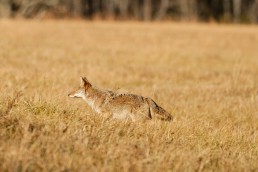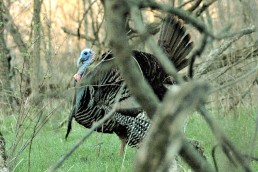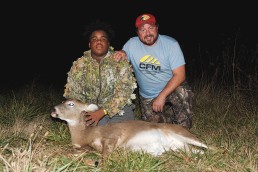Coyote Hunt Benefits the Hungry
SHARE THIS POST
So often, hunters and huntresses are ridiculed because we hunt. We are considered heartless and uncaring individuals. Of course, as hunters, we fully realize that these allegations are far from truth. There is probably no group as compassionate towards animals as us. And, of course, we not only care about the animals we hunt, we also care about our fellow man. That is why I am compelled to write this story!
The second annual Dubois County Coyote Charity hunt took place February 1 through February 2. Hunters were advised of the rules, paid a registration fee to enter the contest, then headed out to help decrease the number of coyotes by call and stalk technique only—no decoys allowed and all Indiana Department of Natural Resource (IDNR) regulations were to be followed. In other words, this wasn’t just a contest to see who could take the most coyotes, it was to remain ethical and completely honest by very worthy sportsmen/women.
Doing good with a good hobby
Kevin Shepherd, manager of Great Outdoors in Jasper, Indiana thanked each hunter for their contribution towards helping feed the hungry. Half of the registration fees were given away to local food pantries.
John Toy, former President of Dubois County Sportsmen’s Club attended the coyote check-in simply because he has a passion towards helping those less fortunate via Hunter’s for Hungry program and wanted to see how hunter success compared to last year.
“Dubois County Sportsman’s Club started the Hunt for Hungry program in 2006, when six deer were donated. The club paid for processing the venison, then donated all the meat to the local food bank. Considering we are in our 13th year now and average over 100 deer annually, we can help surrounding counties as well as Dubois and we still assume all processing fees,” claims Toy.
Toy also shared with me that these coyote hunters should be commended because they happily paid the entrance fee ($100 per team), acknowledging that they would be helping the less fortunate. Each team (consisting of three hunters or less) fully realized that they may pay the entrance fee and come back empty handed, but enjoyed knowing that they were helping such a worthy cause.
Are you enjoying this post?
You can be among the first to get the latest info on where to go, what to use and how to use it!
Fewer coyotes, more venison!
The hunt is divided into two classes. Class 1 includes those teams that harvest less than four coyotes. Class 2 are four or more coyotes. Class 1 team winners claim 1/3 of the pot, while Class 2 claims the other 2/3 of the pot. One-hundred percent of the remaining half pot went straight to the Hunt for the Hungry charity to assist with venison processing fees.
For those that think the Sportsman’s Club forces venison on the poor, think again! Families are offered beef, pork and finally venison. Many families request venison over the other two choices.
“We have had several families ask us for the venison even before we offer the other meats,” states Toy.
Thankfully, there are several processors willing to accept the deer for processing, making it much easier to get the game dispatched quickly—regardless of where the deer was harvested.
So, you see, when we all work together, coyotes can help us feed the hungry! True, we do not consume coyotes, but events such as this accomplish several goals. Coyotes are prolific as well as opportunistic hunters. If they can sneak up on a strutting gobbler when he has his back to the coyote, it can end in disaster for our wild turkey. Coyotes also eat their share of young rabbits, the neighbor’s cat and wreak havoc on our homegrown watermelons.
MWO
SHARE THIS POST
Did you enjoy this post?
You can be among the first to get the latest info on where to go, what to use and how to use it!
Vikki Trout
Vikki Trout is an award winning full-time freelance writer and photographer. She learned to hunt and write from her late husband John. Trusting in Christ, she supports herself to this day.



